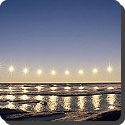 The midnight sun is a natural phenomenon occurring in summer months at latitudes north and nearby to the south of the Arctic Circle, and south and nearby to the north of the Antarctic Circle where the sun remains visible at the local midnight. Given fair weather, the sun is visible for a continuous 24 hours, mostly north of the Arctic Circle and south of the Antarctic Circle. The number of days per year with potential midnight sun increases the farther poleward one goes. There are no permanent human settlements south of the Antarctic Circle, so the countries and territories whose populations experience it are limited to the ones crossed by the Arctic Circle, e.g.. Canada (Yukon, Northwest Territories, and Nunavut), United States of America (Alaska), Denmark (Greenland), Norway, Sweden, Finland, Russia, and extremities of Iceland. A quarter of Finland’s territory lies north of the Arctic Circle and at the country’s northernmost point the sun does not set for 73 days during summer. In Svalbard, Norway, the northernmost inhabited region of Europe, there is no sunset from approximately 19 April to 23 August. The extreme sites are the poles where the sun can be continuously visible for a half year. The opposite phenomenon, polar night, occurs in winter when the sun stays below the horizon throughout the day. Since the Earth’s axis is tilted with respect to the ecliptic by approximately 23 degrees 27 minutes, the sun does not set at high latitudes in (local) summer. The duration of the midnight sun increases from one day during the summer solstice at the polar circle to approximately six months at the poles. At extreme latitudes, it is usually referred to as polar day. The length of the time the sun is above the horizon varies from couple of days at the Arctic Circle and Antarctic Circle to 186 days at the poles. At the poles themselves, the sun only rises once and sets once, each year. During the six months when the sun is above the horizon at the poles, the sun spends the days constantly moving around the horizon, reaching its highest circuit of the sky at the summer solstice. Due to refraction, the midnight sun may be experienced at latitudes slightly below the polar circle, though not exceeding one degree (depending on local conditions). For example, it is possible to experience the midnight sun in Iceland, even though most of it (Grímsey being a notable exception) is slightly south of the Arctic Circle. Even the northern extremities of Scotland (and those places on similar latitudes) experience a permanent “dusk” or glare in the northern skies at these times.
The midnight sun is a natural phenomenon occurring in summer months at latitudes north and nearby to the south of the Arctic Circle, and south and nearby to the north of the Antarctic Circle where the sun remains visible at the local midnight. Given fair weather, the sun is visible for a continuous 24 hours, mostly north of the Arctic Circle and south of the Antarctic Circle. The number of days per year with potential midnight sun increases the farther poleward one goes. There are no permanent human settlements south of the Antarctic Circle, so the countries and territories whose populations experience it are limited to the ones crossed by the Arctic Circle, e.g.. Canada (Yukon, Northwest Territories, and Nunavut), United States of America (Alaska), Denmark (Greenland), Norway, Sweden, Finland, Russia, and extremities of Iceland. A quarter of Finland’s territory lies north of the Arctic Circle and at the country’s northernmost point the sun does not set for 73 days during summer. In Svalbard, Norway, the northernmost inhabited region of Europe, there is no sunset from approximately 19 April to 23 August. The extreme sites are the poles where the sun can be continuously visible for a half year. The opposite phenomenon, polar night, occurs in winter when the sun stays below the horizon throughout the day. Since the Earth’s axis is tilted with respect to the ecliptic by approximately 23 degrees 27 minutes, the sun does not set at high latitudes in (local) summer. The duration of the midnight sun increases from one day during the summer solstice at the polar circle to approximately six months at the poles. At extreme latitudes, it is usually referred to as polar day. The length of the time the sun is above the horizon varies from couple of days at the Arctic Circle and Antarctic Circle to 186 days at the poles. At the poles themselves, the sun only rises once and sets once, each year. During the six months when the sun is above the horizon at the poles, the sun spends the days constantly moving around the horizon, reaching its highest circuit of the sky at the summer solstice. Due to refraction, the midnight sun may be experienced at latitudes slightly below the polar circle, though not exceeding one degree (depending on local conditions). For example, it is possible to experience the midnight sun in Iceland, even though most of it (Grímsey being a notable exception) is slightly south of the Arctic Circle. Even the northern extremities of Scotland (and those places on similar latitudes) experience a permanent “dusk” or glare in the northern skies at these times.
Check Also
Abir Gulaal: 2025 Fawad Khan Hindi Rom-Com Film, Trailer, Review
Movie Name: Abir Gulaal Directed by: Aarti S. Bagdi Starring: Fawad Khan, Vaani Kapoor, Riddhi …
 Kids Portal For Parents India Kids Network
Kids Portal For Parents India Kids Network






